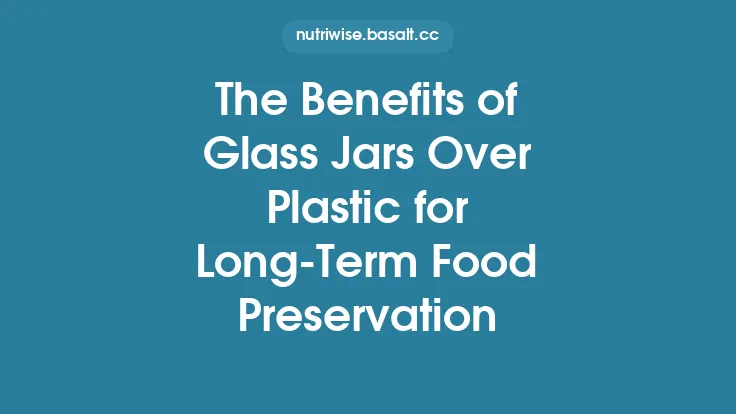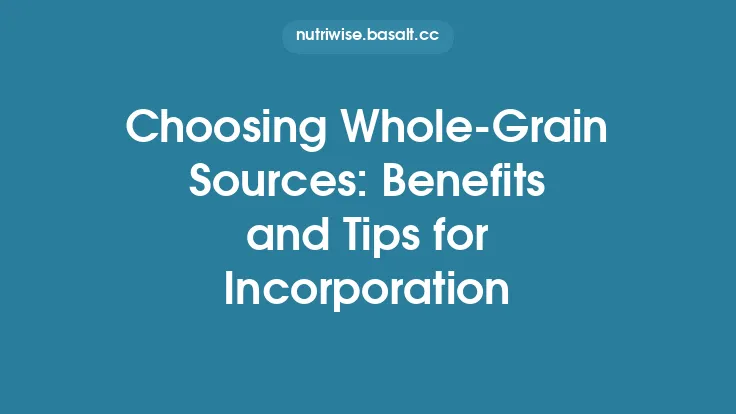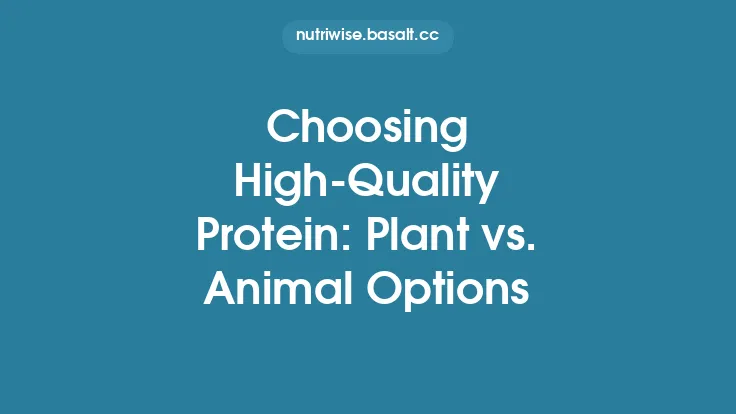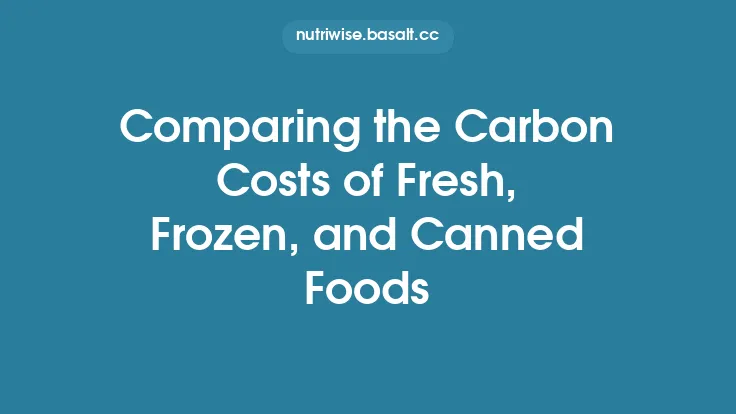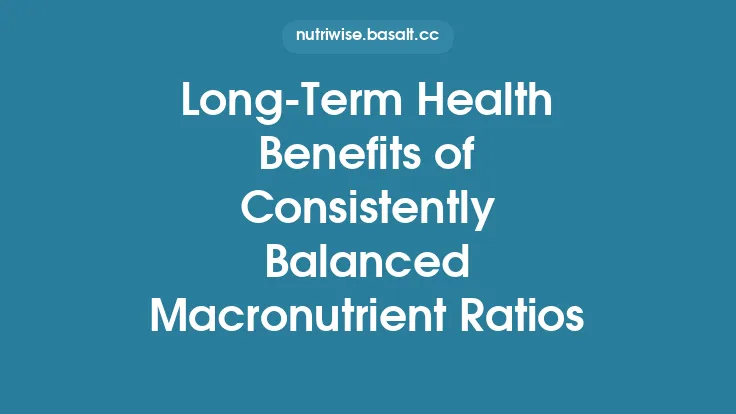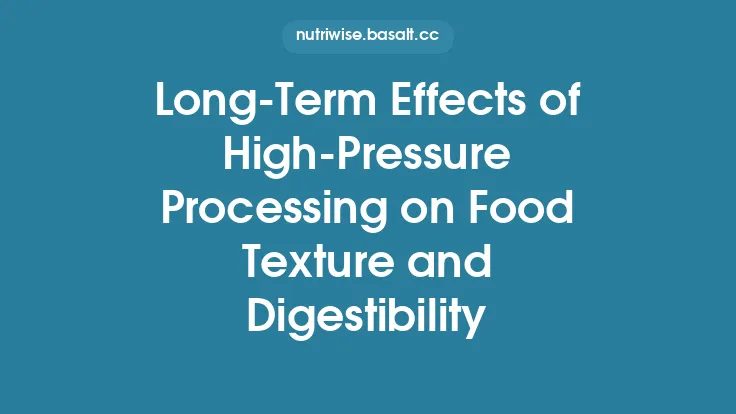Choosing foods that generate fewer greenhouse‑gas emissions is often framed as a short‑term lifestyle tweak—“eat less beef this week” or “swap a dairy latte for oat milk.” While those immediate actions are valuable, the true power of low‑carbon food choices unfolds over decades, reshaping ecosystems, economies, and societies. This article explores the long‑term benefits that accrue when individuals, communities, and institutions consistently favor low‑carbon foods, emphasizing why the habit is more than a personal diet trend and how it becomes a lever for systemic change.
Climate Mitigation and Global Temperature Stabilization
Low‑carbon foods—typically plant‑based proteins, legumes, nuts, and grains cultivated with regenerative practices—emit far fewer kilograms of CO₂‑equivalents (CO₂e) per kilogram of edible product than most animal‑derived foods. When these choices are adopted at scale, the cumulative reduction in emissions directly contributes to meeting the Paris Agreement’s goal of limiting warming to well below 2 °C.
- Life‑cycle emission offsets: A single kilogram of beef can generate 20–60 kg CO₂e, whereas the same weight of lentils produces roughly 0.9 kg CO₂e. If a population of 10 million people each replaces 0.5 kg of beef per week with lentils, the annual avoided emissions exceed 500 million kg CO₂e—equivalent to taking roughly 100,000 passenger‑aircraft flights off the sky.
- Carbon budget preservation: The remaining global carbon budget for a 1.5 °C pathway is estimated at ~400 Gt CO₂. Persistent shifts toward low‑carbon foods can preserve a substantial share of this budget, buying time for other mitigation sectors (energy, industry, transport) to decarbonize.
These macro‑level climate benefits are not fleeting; they compound year after year, reinforcing the trajectory toward a low‑temperature future.
Preservation of Biodiversity and Ecosystem Services
High‑emission livestock systems often require extensive pastureland or feed‑crop cultivation, leading to habitat conversion, fragmentation, and loss of native species. Low‑carbon food production, especially when integrated with agro‑ecological practices, can reverse these trends.
- Land‑use sparing: Plant‑based diets demand far less land per calorie. A shift from a meat‑heavy to a plant‑rich diet can free up millions of hectares, allowing rewilding or restoration of native ecosystems.
- Pollinator support: Diverse cropping systems that supply low‑carbon foods (e.g., legumes intercropped with cereals) provide continuous flowering resources, bolstering pollinator populations essential for ecosystem resilience.
- Reduced chemical inputs: Many low‑carbon production models emphasize reduced synthetic fertilizer and pesticide use, decreasing runoff that harms aquatic biodiversity.
Over decades, these ecological gains translate into more robust food webs, enhanced ecosystem services (e.g., natural pest control, water filtration), and greater resilience to climate shocks.
Soil Health and Carbon Sequestration
Soils are the planet’s largest terrestrial carbon sink, storing roughly 2,500 Gt C—more than the atmosphere’s current carbon pool. Low‑carbon food systems often incorporate regenerative practices that actively draw CO₂ from the air and lock it into soil organic matter.
- Cover cropping and reduced tillage: By maintaining continuous plant cover and minimizing soil disturbance, carbon inputs exceed outputs, leading to net sequestration rates of 0.2–0.5 t C ha⁻¹ yr⁻¹ in many temperate systems.
- Legume nitrogen fixation: Leguminous low‑carbon crops (e.g., beans, peas) naturally fix atmospheric nitrogen, reducing the need for synthetic fertilizers whose production is energy‑intensive and carbon‑heavy. The resulting nitrogen economy improves soil fertility while curbing emissions.
- Biochar integration: Incorporating biochar—stable carbon derived from pyrolyzed biomass—into low‑carbon cropping systems can increase soil carbon stocks for centuries, simultaneously improving water retention and nutrient availability.
When these practices are sustained, soils become long‑term carbon reservoirs, mitigating climate change while enhancing agricultural productivity.
Water Resource Conservation
Food production accounts for roughly 70 % of global freshwater withdrawals. Low‑carbon foods generally require less irrigation than animal‑based products, offering a strategic avenue for preserving dwindling water supplies.
- Lower virtual water content: Producing 1 kg of wheat consumes about 1,300 L of water, whereas 1 kg of beef can demand 15,000 L. Replacing high‑water foods with low‑carbon alternatives reduces the virtual water footprint of diets dramatically.
- Improved water-use efficiency: Regenerative cropping systems often employ mulching, drip irrigation, and soil health improvements that enhance water infiltration and reduce evapotranspiration losses.
- Resilience to drought: Healthier soils with higher organic matter retain moisture longer, buffering crops against intermittent droughts—a critical advantage as climate change intensifies water scarcity.
Over the long term, these water savings support both agricultural stability and the needs of growing urban populations.
Economic Resilience and Food Security
Low‑carbon food production can strengthen economies by diversifying agricultural outputs, reducing reliance on volatile commodity markets, and lowering production costs.
- Reduced input costs: Crops that fix nitrogen or require fewer synthetic fertilizers cut input expenses for farmers, improving profit margins and making agriculture less susceptible to price spikes in fertilizer markets.
- Market diversification: Expanding the portfolio of low‑carbon crops (e.g., pulses, oilseeds) reduces dependence on a narrow set of high‑value, high‑emission commodities, enhancing resilience to pests, diseases, and climate extremes.
- Food‑price stability: Plant‑based foods often have shorter production cycles and can be cultivated on marginal lands, contributing to a more stable and locally sourced food supply that is less exposed to global supply chain disruptions.
These economic benefits accrue over years and decades, fostering a more secure and equitable food system.
Public Health Co‑Benefits
While the focus here is on climate and systemic outcomes, the health advantages of low‑carbon diets reinforce their long‑term societal value.
- Reduced chronic disease burden: Diets rich in legumes, whole grains, nuts, and vegetables are associated with lower incidences of cardiovascular disease, type 2 diabetes, and certain cancers. A healthier population reduces healthcare expenditures and improves workforce productivity.
- Antimicrobial resistance mitigation: Lower demand for intensive animal production can diminish the use of antibiotics in livestock, slowing the emergence of resistant pathogens that threaten global health.
- Nutrient security: Diverse plant‑based foods provide essential micronutrients (e.g., iron, zinc, B‑vitamins) when sourced from varied agro‑ecological zones, supporting long‑term nutritional adequacy.
These health outcomes create a virtuous cycle: healthier individuals are better equipped to adopt and sustain low‑carbon dietary patterns.
Catalyzing Sustainable Agricultural Innovation
Consumer demand for low‑carbon foods drives research and development across the agri‑food sector.
- Breeding for climate resilience: Plant breeders are developing high‑yielding, drought‑tolerant varieties of legumes and cereals, directly responding to market signals for low‑emission crops.
- Alternative protein technologies: Investment in plant‑based and fermented protein platforms accelerates the creation of products that mimic animal textures while maintaining low carbon footprints.
- Digital agronomy: Precision‑farming tools that optimize input use (e.g., variable‑rate seeding, real‑time soil monitoring) become more widely adopted as growers shift toward low‑carbon cropping systems, enhancing overall efficiency.
These innovations, spurred by sustained low‑carbon consumption, generate long‑term gains in productivity, sustainability, and climate mitigation.
Policy and Market Dynamics
Long‑term adoption of low‑carbon foods is reinforced by supportive policy frameworks and market mechanisms.
- Carbon pricing and incentives: When carbon taxes or cap‑and‑trade schemes internalize the true climate cost of high‑emission foods, low‑carbon alternatives become comparatively cheaper, accelerating market share growth.
- Public procurement standards: Government contracts for schools, hospitals, and military bases that prioritize low‑carbon menus create stable demand, encouraging producers to scale up sustainable practices.
- Labeling and certification: Transparent carbon‑footprint labeling empowers consumers to make informed choices, while certification schemes (e.g., regenerative agriculture) provide market premiums that reward low‑emission production.
Over time, these policy levers embed low‑carbon food systems into the economic fabric, making them the default rather than the exception.
Intergenerational Equity and Ethical Considerations
Choosing low‑carbon foods is an act of stewardship for future generations.
- Preserving planetary boundaries: By staying within the global carbon budget, we safeguard the climate system that underpins agriculture, water availability, and biodiversity for children and grandchildren.
- Ethical resource allocation: Lower‑emission diets free up land, water, and energy that can be redirected toward feeding a growing global population without exacerbating climate change.
- Cultural resilience: Supporting diverse, low‑carbon food traditions (e.g., millet, sorghum, pulses) helps maintain culinary heritage while aligning with sustainability goals.
These ethical dimensions reinforce the moral imperative of long‑term low‑carbon food adoption.
Practical Pathways for Long‑Term Adoption
Translating these benefits into everyday reality requires concrete, scalable actions.
- Gradual dietary transition: Incrementally increase the proportion of plant‑based meals—e.g., “Meat‑less Monday” evolving into “Flexitarian Fridays.”
- Support regenerative farms: Purchase from producers who practice cover cropping, reduced tillage, and diversified rotations, either through direct‑to‑consumer channels or certified retailers.
- Invest in community food hubs: Co‑ops and food‑sharing platforms can aggregate low‑carbon produce, reducing transaction costs and fostering local supply chains.
- Educate and empower: Schools and community organizations should integrate climate‑food literacy into curricula, equipping the next generation with the knowledge to sustain low‑carbon choices.
- Leverage technology responsibly: Use digital tools (e.g., farm management apps) to monitor soil carbon, water use, and yield, ensuring that low‑carbon practices remain evidence‑based and continuously improved.
By embedding these strategies into personal habits, community initiatives, and institutional policies, the long‑term benefits outlined above become self‑reinforcing, creating a durable shift toward a sustainable food future.
In summary, the advantages of consistently choosing low‑carbon food options extend far beyond the immediate reduction of greenhouse‑gas emissions. Over decades, they nurture healthier soils, conserve water, protect biodiversity, bolster economic resilience, improve public health, and drive innovation—all while honoring our ethical responsibility to future generations. When individuals, businesses, and governments align around these choices, the cumulative impact can steer the global food system onto a trajectory that safeguards both the planet and its people for the long haul.
